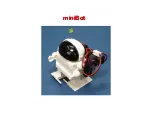
Chapter 7: Technical Specifications
Design Considerations
The following design considerations should be made when selecting an operating envir-
onment.
l
The robot has a cleanroom class 1000 rating.
l
The robot platform and outer arms have an IP67 rating.
l
The underside of the robot body has an IP65 rating.
l
A high level of surface coating adhesion prevents erosion during cleaning.
The aluminum robot base and cover are coated with a Ethylene tetrafluoroethylene
(ETFE) fluorine-based plastic, which will not flake off with repeated high-pressure wash-
ings. This coating is resistant to caustic and chlorinated agents, has strong adherence to
the metal base to resist impact, and has a smooth finish that is easy to clean.
The inner arms will be either electroless nickel-plated aluminum or two-part epoxy
painted aluminum. The assemblies are resistant to some caustic cleaning agents at
room temperature, as well as to chipping.
l
Lubricants are contained within multiple seals.
The gearboxes are sealed internally and sealed externally by a lip seal that is designed
to meet IP65 ratings. All base seal materials are designed to be compatible with caustic
agents and common industrial cleaning procedures.
The inner arms are sealed at the robot base with a rotary V-ring seal. The inner arms
are designed to meet IP65 ratings.
!
CAUTION:
PROPERTY DAMAGE RISK
Like most seals, it is possible to prematurely destroy these seals by delib-
erate, direct, excessive spraying of water-based agents into the sealing
materials.
l
Ball joints and springs and retainers are designed for minimal particulate generation.
The ball studs are stainless steel.
The hemispherical plastic inserts are resistant to caustic agents. The inserts generally
produce few wear particulates. The material used in the inserts is FDA-compliant.
Lubrication of the ball joints is not needed.
l
The theta drive shaft is designed for minimal particulate generation.
l
All moving parts are designed so that small parts are encased within larger assemblies,
and are unable to contaminate the work environment.
l
The outer arms are a composite assembly of carbon fiber and black anodized alu-
minum. The interior volume of the carbon fiber tube is sealed with an internal and
external continuous epoxy bond. The spring retainer pins are press-fit into the outer-arm
ends with a slight interference.
l
The outer arms are attached through the positive pressure of springs that are made of
electro-polished stainless steel. The springs attach to the arms with retainers that fit
over bearing pins on the arms. This open spring-assembly design allows inspection for
contamination as well as wash-down.
l
Platforms are designed to meet IP67 and the basic criteria of wash-down compatibility.
22792-000 Rev. A
iX3 565 Robot with EtherCAT User’s Manual
143














































